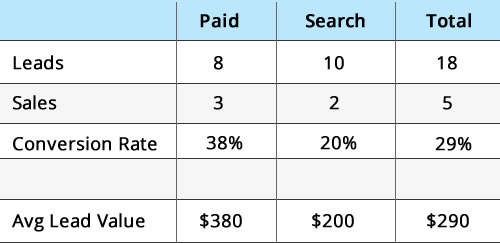

2016-07-12 | 4568 ![]() Print
Print ![]() PDF
PDF
Setting up a website is the very first step of an Internet marketing campaign, and the success or failure of your site depends greatly on how specifically you have defined your website goals. If you don't know what you want your site to accomplish, it will most likely fail to accomplish anything. Without goals to guide you in developing and monitoring your website, all your site will be is an online announcement that you are in business.

If you expect your site to stimulate some form of action, whether it is visitors filling out a form so a representative can contact them, or purchasing a product, there are steps you can take to insure that your website is functioning at peak efficiency. One of the first indicators of how well your site is working for you is finding out the number of visitors in a given period of time. A good baseline measurement is a month in which you haven't been doing any unusual offline promotional activities.
Recommended Read: How To Analyze Your Website Traffic
However, just because hoards of people have passed through your gates does not mean your site is successful. Usually, you want those visitors to actually do something there. It is equally important to monitor the number of visitors to your site who made a purchase or complete a goal. This figure is called the site conversion rate, and it is an essential element of the efficacy of your website performance index and lead generation potentials.
To find the site conversion rate, take the number of visitors per month and figure out the percentage of them that actually performed the action your site is set up for.
Conversion Rate = Total Number of Sales / Number of Leads * 100
Example: Let’s say you made 20 sales last year and you had 100 inquiries/ leads. Your sales to lead conversion rate would be 20%.
If you’re tracking conversions from website leads, your formula looks like so:
Conversion Rate = Total Number of Sales / Number of Unique Visitors * 100
Example: If you made 10 sales in a month and you had 1,000 unique visitors to your site, your conversion rate would be 1%.
The cost of a lead is the total amount you have spent to acquire such leads, while lead value is the amount of sales generated by the total number of leads, you can also analyze if your lead acquisition is expensive or cheaper via the platform you utilize to acquire this leads. eg Google PPc or Facebook Ads. If you sell mechanical kit systems at an average price of $2,000 and were able to turn a lead into a sale, then that lead is worth $2,000 to you.
However, its a fact that not every lead you get will end up in a sale. In reality you might only turn two out of 10 inquiries into a sale. That would make your conversion rate 20% (2/10 * 100 = 20).
That means you can expect to generate about $4,000 from your 10 leads (2 sales @ $2,000 each). That’s because we know on average you are closing 2 out of 10 sales, a 20% conversion rate. This means that the value of one lead is actually $400 (4,000/10).
Here’s the formula:
Lead Value = Value of Sale / Number of Leads
The previous example is a simple method, you can get much deeper with this stuff. As we discussed earlier, some leads will be more qualified than others and we will also want to look at what the actual profit is – not just the revenue. More on that in a minute.
When you know what the value of a lead is, you can determine how many leads you need each month to sustain your business and how much you should pay for advertising. This is true whether you are using pay-per-click (PPC) or any offline advertising like mailers or print ads.
Conversions Needed = Desired Revenue / Lead Value
Example: Let’s say you need to generate $15,000 per month to sustain your mechanical kit business. Based on your conversion rate of 20% (2 sales / 10 leads x 100 = 20) from the previous example, you already know that each lead is worth about $400 (4,000/10).
This means, you would need about 37-38 leads per month (15,000 / 400 = 37.5) to make about 7-8 sales ($2,000 each) and generate $15,000 in revenue.
(Note: This is a simple illustration using revenue generated. A more accurate option would be to use the profit generated by sales and not just the revenue, but many businesses have difficulty defining this number so we use revenue as a guide.)
Example: If each sale of $2000 actually costs you $1000 to deliver, the profit on each sale is really $1000. To get a return on your advertising spend you’ll actually need to generate 75 leads to reach your $15,000 monthly goal.
The math:
1 sale = $1000 profit
Conversion rate = 20% (2/10 * 100 = 20%)
Average lead Value = $200 ($1000 * 20%)
Leads needed = 75 ($15,000 / $200 = 75)
Even if you use revenue instead of actual profit, as long as you are constantly tracking these metrics, you will be able to make much more informed decisions.
Understanding your sales funnel, can help you determine the number of leads you need to get each month, how much you can safely spend on advertising and what you can expect in return.
In the business world things aren’t always so simple. Not all sales are going to be equal. Some sales will be a homerun and others won’t.
Also, the conversion rates are going to be different depending on the traffic source. You may find that leads generated by paid search convert better because you’ve been hyper-focused on your advertising, using keywords with extremely high commercial intent and/or targeting customers that are very local to you.
So with an average order value of $2000 you might see something like this:

From this, you can see that a lead generated from your paid search campaign is worth more to you than a lead generated from organic search.
If you have Google analytics installed on your site (and you should) you can determine the average lead value and enter this into your analytics goal, then Google Analytics will do most of the hard work for you.
If you just stuff the average revenue value into the goal value, you’ll see highly inflated numbers that won’t make sense, as not every lead generated from the website will actually result in a sale.
Using a realistic lead value as your goal value will give you a clearer insight into how your website is performing.
If you have any questions, feel free to leave your comment below.
If your website is set-up to get visitors to fill out a form, make sure to then figure out what the difference is between your site conversion rate and your sales conversion rate. This is because not everyone who fills out your form will actually become your customer. However, whether your site is set-up to sell a service or product, or to get the visitor to fill out a form, the site conversion rate will measure the success or failure of your website whenever you
make changes to the site.
Recommended Read: 12 Things To Do When Designing Website User Experience Using User Testing.
You may find that you need to implement some additional marketing strategies if you find that traffic to your site is extremely low. There are several effective methods to improve the flow of traffic to your website, particularly launching a search engine optimization campaign. This campaign is targeted at increasing your position in search engine results so that consumers can find your pages faster and easier. You can either research the steps you need to take to improve your search engine rankings, or employ a search engine optimization company to do the work for you.
In either case, after your have improved your search engine positions, make sure you keep on top of them by regular monitoring and adjusting of your efforts to maintain high positions.
Another factor to examine is how easy it is for a visitor to your website to accomplish the action the site is set-up for. For example, if your goal is for the visitor to fill out a form, is this form easily accessible, or does the visitor have to go through four levels to get to it? If it's too difficult to get to, the customer may just throw in the towel and move on to another site. Make sure your buttons are highly visible, and the path to your form or ordering page quickly accessible.
Finally, have a professional evaluate the copy on your website. The goal is, of course, to get your visitor to make a purchase or fill out your form. Website copy must be specifically geared to your online campaign and not just a cut and paste job from your company brochure. The right copy can make the difference between profit and loss in your online campaign.

I am a seo web analyst and have a love for anything online marketing. Have been able to perform researches using the built up internet marketing tool; seo web analyst as a case study and will be using the web marketing tool (platform).
How To Fix GA4 Showing Wrong Domain Traffic
How To Reactivate Google Adsense Account
How Do You Write Pitch Deck That Wins Investors
Effective Lead Magnet Funnel Examples For Businesses
How To Promote FMCG Products Using Digital Marketing
The Main Objectives Of SEO in Digital Marketing
How Artificial Intelligence Is Transforming Digital Marketing
Google CEO Sundar Pichai: Search will profoundly change in 2025
3 Most Important Business Growth Strategies
Top 20 Work From Home Job Skills